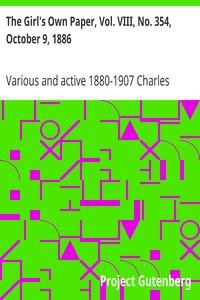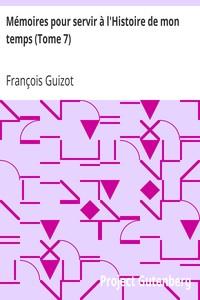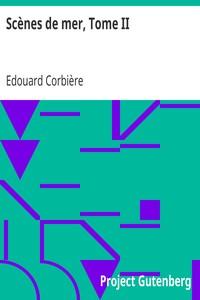|
|
Read this ebook for free! No credit card needed, absolutely nothing to pay.Words: 10079 in 5 pages
This is an ebook sharing website. You can read the uploaded ebooks for free here. No credit cards needed, nothing to pay. If you want to own a digital copy of the ebook, or want to read offline with your favorite ebook-reader, then you can choose to buy and download the ebook.

: The Girl's Own Paper Vol. VIII No. 354 October 9 1886 by Various Peters Charles Active Editor - Children's literature Periodicals The Girls Own Paper@FreeBooksTue 06 Jun, 2023 HOW BUTTONS ARE MADE. It is scarcely possible to determine when buttons, which are both useful and ornamental, were first made. In the paintings of the fourteenth century they frequently appear on the garments of both sexes, but in many instances they are drawn without button-holes, and are placed in such situations as to suggest that at that time they were used more for ornament than usefulness. It was towards the close of the sixteenth century that button-making was first considered a business, and that the manufacturers formed a considerable body. Button-making was originally a very tedious and expensive process. The button consisted of one solid piece of metal; the ornaments on the face of it were the work of an engraver. To obviate the expense connected with such a method of production, the press, stamp, and engine for turning the moulds were introduced. This improvement led the way for other improvements, both with regard to the materials from which buttons were afterwards made and also the process of manufacture. The plain gilt button, which was extensively used in the early part of the present century, was made from an alloy called plating metal, which contained a larger proportion of copper and less zinc than ordinary brass. The devices on the outer surface were produced by stamping the previously cut out blanks or metal discs with steel dies, after which the necks were soldered in. At the present time every possible kind of metal, from iron to gold, whether pure or mixed; every conceivable woven fabric, from canvas to the finest satin and velvet; every natural production capable of being turned out or pressed, as wood, horn, hoof, pearl, bone, ivory, jet, ivory nuts; every manufactured material of which the same may be said, as caoutchouc, leather, papier mach?, glass, porcelain, etc., buttons are made in a great variety of shape; but at the present time they may be classed under four heads: buttons with shanks, buttons without shanks, buttons on rings or wire moulds, and buttons covered with cloth or some other material. In the process of metal button-making by means of fly presses and punches, circular discs, called blanks, are cut out of sheets of metal. This work is usually done by females, who, while seated at a bench, manage to cut out as many as thirty blanks per minute, or twelve gross in an hour. On leaving the press the edges of the blanks are very sharp. When they have been smoothed and rounded, the surfaces are planished on the face by being placed separately in a die, under a small stamp, and causing them to receive a sharp blow from a polished steel hammer. The next process is that of shanking, or attaching small metal loops, by which they are fastened to garments. The shank manufacture is a distinct branch of the trade in Birmingham, although at times carried on in the same factory. The shanks are made by a machine, in which a coil of wire is gradually advanced towards a pair of shears, which cut off short pieces. A metal finger then presses against the middle of each piece, first bending it and then pressing it into a vice, where it is compressed so as to form a loop; a hammer then strikes the two ends, spreading them into a flat surface, and the shank is pushed out of the machine ready for use. The shanks in some instances are attached to the blanks by women with iron wire, solder, and resin, after which they are placed in an oven, and when firmly united are removed and form plain buttons. In the majority of cases, however, soldering is dispensed with, the shanks being made secure in the press. If the button is to be finished without a shank, it is passed on from the press, which it leaves as a blank, to another where the holes are pierced, and then to a third where the roughness is removed from the edges of the holes. The commonest metal buttons which I have seen in process of making were cut out of scraps of tin, similar to what may be seen on the refuse heap of any shop where tin goods are made. The hand presses worked by women cut out the blanks, made a simple impression on the outside, and turned up the edges all round at the same time. The blanks were then passed on to another press, where pieces of cardboard were inserted, and the edges turned over to keep them firm. The holes were next pierced, and a finish given by a blow from a stamp. Military buttons, like many others, are made of two discs of metal, the impression on the outer ones being produced by a sharp blow in a stamp, the under ones having two holes pierced in them for the shanks, which are put through and bent flat on the inside. They are next passed through another press which firmly fastens the two discs together, and holds the shank so securely as to obviate the necessity of having recourse to soldering. Covered buttons are made in an immense variety of textiles. It is impossible in the space allowed for this paper to enumerate them, but I may add that their ingenious construction, their good wearing qualities, the clever mechanism of the tools by which the various discs of cloth, metal, millboard, etc., are cut out, and the methods of uniting them so as to form a complete button, are marvels of skill and industry. The earliest covered buttons were made so recently as the year 1802, in Birmingham, by Mr. B. Sanders. Those buttons had metal shanks, but by the ingenuity of Mr. Sanders, jun., his father's invention was completed by tufts of canvas, through which the buttons could be attached to garments, being substituted for rigid metal shanks. The only improvement since made has been that of covering the back of the silk-fronted buttons also with silk. A covered button consists of two discs of metal and one of millboard, thicker or thinner, according to circumstances. In making it, the sheet of iron is first scaled, by the use of powerful acids, and then cut into proper size and shape by a press. The neck, or collet, of the button is japanned after being stamped and cut. The hollow between the neck and shell is filled with millboard. When the parts are put together and pressed the button is brought into shape, and its several parts are consolidated. Free books android app tbrJar TBR JAR Read Free books online gutenberg More posts by @FreeBooks
: Diario de un viage a la costa de la mar Magallanica by Lozano Pedro - Patagonia (Argentina and Chile) Description and travel; Argentina Discovery and exploration Argentina@FreeBooksTue 06 Jun, 2023

: Northern Nut Growers Association report of the proceedings at the sixth annual meeting Rochester New York September 1 and 2 1915 by Northern Nut Growers Association Editor - Northern Nut Growers Association Periodicals; Nut trees Periodicals; Nuts Periodi@FreeBooksTue 06 Jun, 2023
|
Terms of Use Stock Market News! © gutenberg.org.in2025 All Rights reserved.






